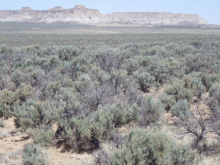Article
Sagebrush, often shortened to "sage," is the name of a group of plants that are commonly referred to as sagebrushes or sageworts. These are plants in the genus Artemisia, a large genus in the daisy and ragweed family, and are often used as a culinary herb or tea in different cultures around the world. The sagebrush that is native to the American Southwestern regions is a low-growing bush that is characterized by its grayish-green color and aromatic leaves.
Sagebrush is widely used in various Native American ceremonies, and is thought to have cleansing and healing properties. Traditionally, sage leaves are dried and tied into bundles that in English are called "smudge sticks." when the end of the smudge stick is lit and allowed to smolder, the dried, tightly-bound sage leaves burn slowly like incense, producing thick smoke that is believed to act as an energy cleanser and protector for a person or a dwelling place.
"Sagebrush steppe, San Juan County, New Mexico, May 17, 2013" by Matt Lavin is licensed under CC BY-SA.
Manuscripts
References
Germplasm Resources Information Network
2007 Genus: Artemisia L. . United States Department of Agriculture.
Kershaw, Linda
2000 Edible and Medicinal Plants of the Rockies. Edmonton, Alberta: Lone Pine
Publishing.
Kindscher, Kelly
1992 Medicinal Wild Plants of the Prairie. Lawrence, KS: University of Kansas Presses.

